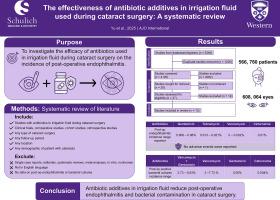The effectiveness of antibiotic additives in irrigation fluid used during cataract surgery: A systematic review
引用次数: 0
Abstract
Purpose
To conduct a systematic review investigating the efficacy of antibiotics used in irrigation fluid during cataract surgery on the incidence of post-operative endophthalmitis.
Design
Systematic review of literature.
Methods
Literature was searched through MEDLINE, EMBASE, CINAHL, ClinicalTrials.gov, and ProQuest Dissertations and Theses until February 17, 2024. Conferences held through the Association for Research in Vision and Ophthalmology and American Academy of Ophthalmology were searched until March 22, 2024. A total of 5341 records were screened leaving 13. One author independently reviewed them for quality and extracted data. The Preferred Reporting Items for Systematic Reviews and Meta-Analyses (PRISMA) reporting guidelines were followed. Data on the types of antibiotics used, as well as the incidence of post-operative endophthalmitis and complications, were extracted.
Results
A total of 608,064 eyes and 566,760 patients were included in the current study. Surgical procedures included phacoemulsification, manual small-incision, and extracapsular extraction. Results showed antibiotic additives reduced postoperative endophthalmitis and bacterial contamination. Vancomycin showed the lowest infection rates, with one study reporting 0 infections out of 220 patients using a concentration of 20 mg/L. Similarly, gentamicin, tobramycin, and cefuroxime also demonstrated reduced infection rates, with gentamicin achieving rates as low as 0.008 % at higher concentrations. Combination therapy with vancomycin and gentamicin further reduced bacterial contamination, with culture positivity rates as low as 2.73 %. In comparator groups without antibiotics, infection rates were significantly higher, ranging from 0.04 % to 0.07 %. No adverse events or complications were reported in those who received antibiotics in their irrigation fluid.
Conclusions
Antibiotic additives in irrigation fluid reduce postoperative endophthalmitis and bacterial contamination in cataract surgery. These findings support their inclusion in surgical practice to improve patient outcomes. Based on the current systematic review, the overall quality of evidence is moderate, as findings are supported by a mix of randomized controlled trials and observational studies with some heterogeneity. Further high-quality RCTs are needed to determine optimal antibiotic concentrations and establish standardized guidelines.

白内障手术冲洗液中抗生素添加剂的有效性:系统综述
目的对白内障手术中应用抗生素冲洗液对术后眼内炎发生率的影响进行系统评价。设计文献系统综述。方法通过MEDLINE、EMBASE、CINAHL、ClinicalTrials.gov和ProQuest等检索文献,检索截止日期为2024年2月17日。通过视力和眼科研究协会和美国眼科学会举行的会议被检索到2024年3月22日。总共筛选了5341条记录,剩下13条。一位作者独立审查了它们的质量并提取了数据。遵循系统评价和荟萃分析(PRISMA)报告指南的首选报告项目。提取了抗生素使用类型以及术后眼内炎和并发症发生率的数据。结果共纳入608064只眼,566760例患者。手术包括超声乳化术、手工小切口和囊外摘除术。结果显示抗生素添加剂减少了术后眼内炎和细菌污染。万古霉素的感染率最低,一项研究报告使用浓度为20mg /L的万古霉素的220例患者中0例感染。同样,庆大霉素、妥布霉素和头孢呋辛也显示出降低感染率,在较高浓度下,庆大霉素的感染率低至0.008%。万古霉素和庆大霉素联合治疗进一步降低了细菌污染,培养阳性率低至2.73%。在未使用抗生素的比较组中,感染率明显高于对照组,为0.04%至0.07%。在冲洗液中使用抗生素的患者无不良事件或并发症报告。结论应用抗生素灌洗液可减少白内障术后眼内炎和细菌污染。这些发现支持将其纳入外科实践以改善患者预后。根据目前的系统综述,证据的总体质量是中等的,因为这些发现得到了随机对照试验和具有一定异质性的观察性研究的支持。需要进一步的高质量随机对照试验来确定最佳抗生素浓度和建立标准化指南。
本文章由计算机程序翻译,如有差异,请以英文原文为准。
求助全文
约1分钟内获得全文
求助全文

 求助内容:
求助内容: 应助结果提醒方式:
应助结果提醒方式:


